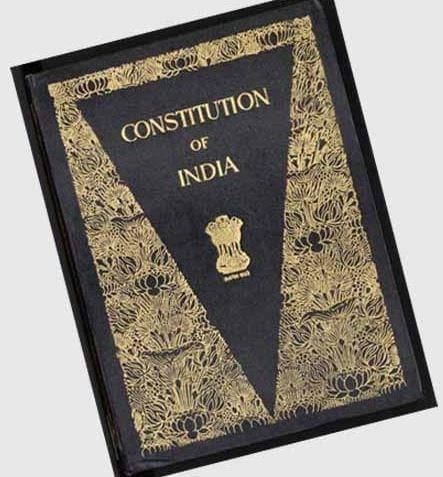Amendment Of Indian Constitution | Social Science Class 8 - New NCERT PDF Download
Theory of basic structure: a limitation on amending power.
The validity of the Constitution (24th Amendment) Act 1971, was challenged in Keshvananda Bharti vs. the state of Kerala (AIR 1973 SC 1461). This 13-judge bench decided that the 24th amendment is valid and the power to amend the constitution is found in Art. 368 itself. Further, the court recognized that there is a distinction between ordinary law and constitutional law.
 Fig: Indian Constitution.
Fig: Indian Constitution.
This could impliedly mean that Art.368 confers power to even abridge a fundamental right and to this extent, the Golaknath case was overruled. But 7 of the judges held that the power of amendment under article 368 is subject to certain implied and inherent limitations and that in the exercise of amending the basic structure or framework of the constitution.
So the majority was of the opinion that the amending power under Article 368 is subject to the qualification that this amending power cannot be exercised to alter the basic structure of the framework of the constitution. Such as
(1) Supremacy of the constitution.
(2) Republican and democratic form of govt.
(3) Secular character of the constitution.
(4) Separation of power.
(5) Federal character of constitution
In Indira Gandhi vs. Raj Narain (AIR 1975 SC 2299), the SC referred to the Keshavananda Bharti case and accepted the doctrine of the basic structure of the framework of the constitution.
The validity of thirty ninth amendment (1975) of the constitution was in question.
This amendment excluded judicial review of elections and laws relating to elections. This amendment was held to be invalid by the SC as it altered a basic feature of the constitution; the judicial review in election disputes.
[Question: 893530]
To neutralise the effect of the doctrine of the basic structure, the Govt. enacted the Constitution (42ND Amendment) Act 1979 and added clauses (4) and (5) to art. 368 which provided for exclusion of judicial review of amendments of the constitution made before or after the 42nd Amendment. It also declared that there shall be no limitation on the amending power of the parliament under Article 368.
The court held that clauses (4) and (5) of Art. 368 are unconstitutional as they affect the basic structure of the constitution i.e. judicial review. However, there was difference of opinion on validity of amended article 31-C which gave primacy to all Directive principles over the fundamental rights.
Although the minority declared void the amended article 31-C, justice Bhagwati (minority judgment) upheld it by giving a restrictive interpretation in terms of doctrine of basic structure.
In Minerva mills vs. union of India (air 1980 sc 1789) The SC by 4 to 1 majority struck down clauses (4) and (5) of article 368 inserted by the 42nd amendment as these clauses destroyed the essential features of the basic structure of the constitution. And held that the following are basic structure of the constitution:
- limited power of parliament to amend the constitution;
- harmony and balance between fundamental rights and directive principles;
- fundamental rights in certain cases;
- power of judicial review in certain cases;
Independence of judiciary is part of the basic structure.
In Woman Rao vs. Union of India (AIR 1881 SC 271) The supreme court held that all amendment to the constitution which were made before April 24th, 1973(i.e.. the date on which the judgment of Keshvananda Bharti was delivered )including those by which the ninth schedule to the constitution was amended from time to time were valid and constitutional.
 Fig: Judiciary.
Fig: Judiciary.
In S.P. Sampat kumar vs. union of India (AIR 1987 SC 271), the Supreme Court upheld the validity of art. 323-A and the Act as the necessary changes suggested by the court were incorporated in the Administrative Tribunal Act.
In a landmark judgment in L.Chandra kumar vs. union of India (AIR 1997 SC 1125) a seven-member constitutional bench of the Supreme Court has unanimously while reconsidering the SAMPATH KUMAR'S CASE, has struck down clause 2(d) of articles 323 A and clause 3(d) pf art.
323 B which provided for the exclusion of the jurisdiction of the high courts under articles 226 and 227 and the Supreme Court under article 32 of the constitution as unconstitutional and invalid as they damage the power of judicial review which is the basic structure of the constitution.
Necessity of amending provision in the Constitution
It is made with a view to overcome the difficulties which may be encountered in the future in the working of the constitution.
The nature of amending "amending process" envisaged by the framers of our constitution can best be understood by referring to the following observation of the late prime minister pt. Nehru, "while we want this constitution be as solid and permanent as we can make it, there is no permanence in the constitution. There should be certain flexibility.
If you make anything rigid and permanent you stop the nation's growth, of a living vital, organic people. In any event, we could not make this constitution so rigid that it cannot be adopted to changing conditions.
When the world is in a period of transition what we may do today may not be wholly applicable tomorrow" practically every constitution has some formal provisions for amendment of the constitution. In a rigid constitution amendment is more elaborate and difficult then enactment of ordinary legislation. In a flexible constitution, amendment can be affected rather easily, as easily as enacting an ordinary law.
The former procedure to amend some foreign federal constitutions as follows:
- U.S.A.: In U.S.A., amendment of the constitution may be proposed only by congress, with the approval of 2/3 of majority of both houses (congress and senate), or a convention summoned on an application from 2/3 of the members of both houses. The proposed amendments must be ratified by at least ¾ of the total number of the state legislatures or by conventions in ¾ of the total numbers of the states.
- SWITZERLAND: In Switzerland, no alteration of the constitution can be effected without resorting to a referendum.
- AUSTRALIA: In Australia, the constitution can be altered only by an Act passed by an absolute majority in both houses, or in case one house refuses to pass it, by an Act passed by an absolute majority in either house, for the second time, after an interval of 3 months. But in either house the Act must be subjected to a referendum in each state.
If in a majority of the states, a majority of the voters approve the amendment, it shall be presented to the governor general for the Royal assent. In INDIA the framers of the constitution devoted a separate chapter (20th ) towards the process and provisions of amendment of the provision of the constitution fall under 3 categories:
(a) Those provisions of the constitution which can be affected by a simple majority required for the passing of an ordinary law:-the amendment contemplated in Articles 4,169,239(A) fall within this category. These articles are specially excluded from the area of Art. 368.
(b) Those provisions of the constitution that can be affected by a special majority as laid down in Art. 368: under this category the amendments are effected by a majority of total membership of either of each house of parliament as well as by a majority of not less than 2/3 of the members of that house present and voting.
(c) Those provisions of the constitution which require in addition to the special majority as described in 368(2), ratification by a resolution passed by not less than one half of the state legislature, before the bill is presented to president for his assent:-some of these provisions in which amendment can be made by aforesaid procedures are
(1) the election and manner of election of the president(art. 54& 55),
(2) extent of executive power of the state(art. 73),
(3) provision dealing with high court for union territories (art. 241),
(4) seventh schedule of the constitution.
(5) Art. 368 itself.
The power to amend the constitution conferred on parliament includes the power to amend art. 1 and logically would include the power to cede national territory in favour of a foreign state.
|
31 videos|128 docs|7 tests
|
FAQs on Amendment Of Indian Constitution - Social Science Class 8 - New NCERT
| 1. What is the process for amending the Indian Constitution? |  |
| 2. Why is the amendment process important for the Indian Constitution? |  |
| 3. Can state legislatures propose amendments to the Indian Constitution? |  |
| 4. What are some notable amendments to the Indian Constitution? |  |
| 5. What are the limitations on the power to amend the Indian Constitution? |  |
















